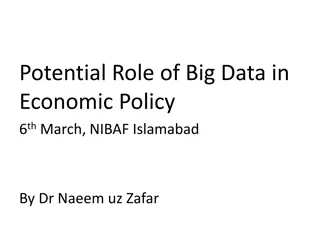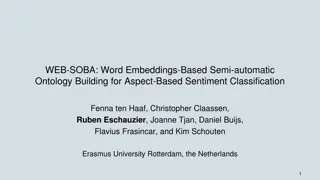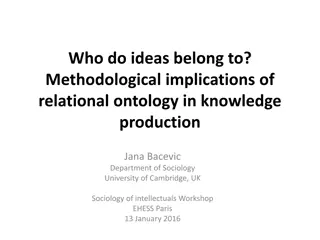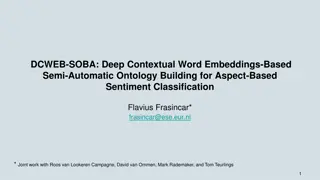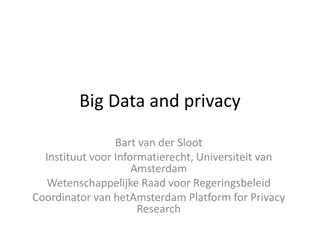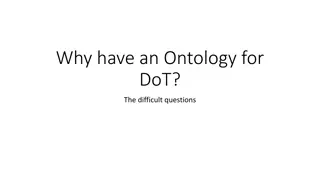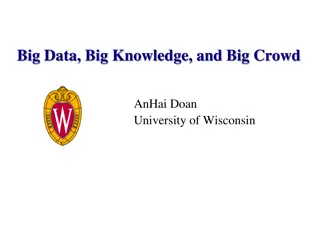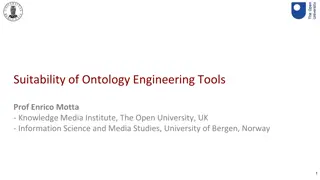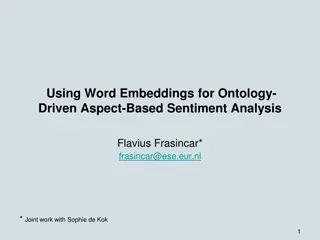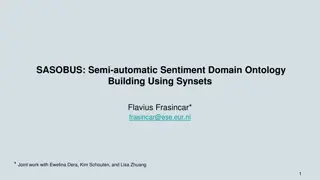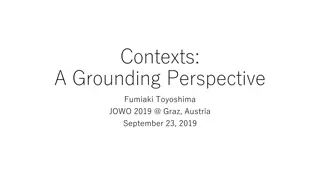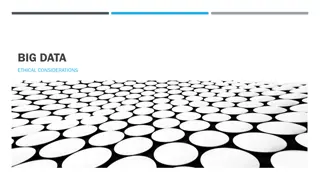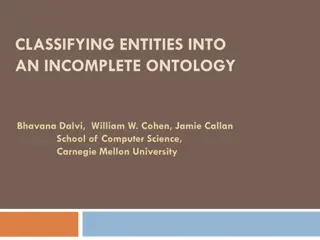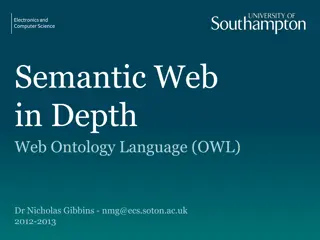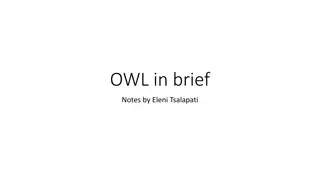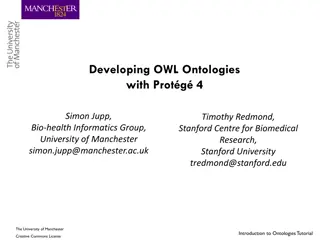Framework for Ontology Learning from Big Data with IDRA
IDRA (Inductive Deductive Reasoning Architecture) presents a comprehensive framework for ontology learning, focusing on data modeling and architecture components. ETL (Extract Transform Load) processes play a vital role in semantic enhancement of data, especially in identity and access governance contexts. Strategies for managing uncertainty, both objective and subjective, are key aspects of the approach. The IDRA concept entails structural components like a statements generator and repository for learning ontology model statements.
Download Presentation

Please find below an Image/Link to download the presentation.
The content on the website is provided AS IS for your information and personal use only. It may not be sold, licensed, or shared on other websites without obtaining consent from the author.If you encounter any issues during the download, it is possible that the publisher has removed the file from their server.
You are allowed to download the files provided on this website for personal or commercial use, subject to the condition that they are used lawfully. All files are the property of their respective owners.
The content on the website is provided AS IS for your information and personal use only. It may not be sold, licensed, or shared on other websites without obtaining consent from the author.
E N D
Presentation Transcript
IDRA A FRAMEWORK FOR ONTOLOGY LEARNING FROM BIG DATA Ing. Roberto Enea Senior Software Engineer @SecureAuth
Summary IDRA (Inductive Deductive Reasoning Architecture): General Framework for Ontology Learning Challenge Architecture and Data Model (LOM) Components Kevin: an IDRA Use Case to collect user data in order to highlight risk factors for Social Engineering Attack Susceptibility Facebook Crawling Evaluation Criteria
ETL (Extract Transform Load) The main result of the ETL process is to give a new and useful semantics to data. Examples in Identity and Access Governance Abandoned Accounts Orphan Accounts
ETL from Web Challenge Managing Data Evolution Change of perspectives: not only documents but sources Managing Volume New data storage approaches are needed Managing Uncertainty
Managing Uncertainty two different kinds of uncertainty: objective and subjective. An objective uncertain data is something that is inherently uncertain. As an example, we could mention the daily weather forecast where the chance of rain is expressed with a given probability. The subjective uncertain data represents facts that are inherently true or false, but their value is hard to be defined because of data noise. Our aim is to reduce subjective uncertainty of extracted facts in order to embed them in the learning ontology
Managing Uncertainty Our approach can be summarized by the following features: Use of a value in the range of [0,1000] to represent the level of uncertainty of an axiom (RDF statement) coming from the ontology learning process. The value depends on: The algorithms used to extract the statement The sources reliability A dedicated infrastructure to manage the LOM (Learning Ontology Model) including management of the confidence level (the confidence level is not included in the learned ontology) Providing a tool for running SPARQL what-if queries to the user, in order to let him investigate and validate uncertain statements using an interrogative model approach
Structural Components Statements Generator: The module implementing the statements generation. Statements Repository: the repository storing the LOM Statements Modulator: This module update the confidence level of the incoming triples Analysis tools (query What if, Reasoner)
Domain dependent components Domain Ontology: the ontology including the initial ontology and inference rules Analysis Engines (UIMA annotators): the set of annotators specific for each source monitored Projection Rules: the rules used to map the annotation to the domain ontology. It is used by CODA to generate the triples Inference Rules: the set of rules to infer the required categorization on data Crawler: the module dedicated to data extraction. It is strictly related to the source monitored.
IDRA Architecture Statements Generator FB LAM Statements Generator Wiki (Learned Axioms Manager) Statements Generator RG
Statements Generator REST Interface Analysis Engine (UIMA Annotator) Triples CODA Crawler Sources Domain Ontology Projection Rules
Learned Axiom Manager REST Interface Triples Domain Ontology Statements Modulator SPARQL Parser Reasoner Inference Rules Repository
LOM Data Model The main entity of the model is the Triple. It contains some important attributes required for the managing of uncertain statements: the confidence level the number of occurrences the source If a single instance of a triple is extracted from the analyzed documents the SM will assign to the triple the same confidence level coming from the SG, otherwise it will calculate the average of the confidence level increasing the number of occurrences. The source indicates the original corpus the statement has been extracted from.
In-Memory graph DBs Based on Binary Matrices used as Adjacency matrices to store Relationships between entities All the indexes are stored in memory Persistence is used just from not frequently accessed properties
In-Memory graph DBs Adjacency matrices make the indirect relationship computation easy Facebook Profile Places X Y Z A B C Friends a b c d e f g h i l m n f g h i l m n Users X Y Z Friends Facebook Profile
In-Memory graph DBs In order to compute the relationships between the Users and the places where their friends live, It is enough to compute the Boolean matrix product of the three matrices above Places A B C X Y Z f g h i l m n A B C a b c d e f g h i l m n a b c d e X Y Z Users
In-Memory graph DBs Hierarchy navigation a b c d e f g h a b c d e f g h a a b c d e f g h c a b c d e f g h b e d g f h
Use case: Kevin Detection system of people at risk of SE Attacks. Sources: main social networks Domain ontology: based on common HR Db entities Inference rules coming from: Samar Muslah Albladi and George R. S. Weir, User characteristics that influence judgment of social engineering attacks in social Networks
Facebook Crawling In order to overcome several blocking systems adopted by Facebook to avoid crawling I considered to use: Selenium: A java library for Web UI Automation, usually used by QA Engineers Several Agents (fake profiles with no friends to not influence Facebook search) Random delays between actions to simulate human behavior
Projection Rules Strategy The confidence level is evaluated using the edit distance between the field extracted and the corresponding information in HR Profile. It is applied to the hasFacebook profile relationships, while the relationships between Facebook profile and its attributes have the maximum cl CL=1000 HR Job Profile Facebook Profile CL[0, 1000] Education Company
Inference Rules Rule name Rule Description Identifiable Person(?x) ^ kevin-ontology:hasFacebookProfile(?x, ?y) -> kevin- ontology:Identifiable(?x) kevin-ontology:Person(?x) ^ kevin-ontology:FacebookProfile(?y) ^ kevin-ontology:hasFacebookProfile(?x, ?y) ^ kevin- ontology:hasJob(?y, ?z) ^ kevin-ontology:livingPlace(?y, ?l) ^ kevin- ontology:spouse(?y, ?h) ^ kevin-ontology:studied(?y, ?d) ^ kevin- ontology:studiedAt(?y, ?m) ^ kevin-ontology:workFor(?y, ?u) -> kevin- ontology:HighInformationDisseminator(?x) kevin-ontology:Identifiable(?x) ^ kevin- ontology:HighInformationDisseminator(?x) -> kevin- ontology:VerySusceptibleToSEA(?x) kevin-ontology:Person(?x) ^ kevin-ontology:FacebookProfile(?y) ^ kevin-ontology:hasFacebookProfile(?x, ?y) ^ kevin- ontology:livingPlace(?y, ?l) ^ kevin-ontology:studiedAt(?y, ?m) ^ kevin-ontology:workFor(?y, ?u) -> kevin- ontology:MediumInformationDisseminator(?x) kevin-ontology:MediumInformationDisseminator(?x) ^ kevin- ontology:Identifiable(?x) -> kevin- ontology:ModeratelySusceptibleToSEA(?x) HighInformationDisseminator VerySusceptibleToSEA MediumInformationDisseminator ModeratelySusceptibleToSEA
Inference Rules The inference Rules are expressed in SWRL language because: It is flexible (a lot of built-in function that let the user implement advanced rules) It starts from OWA It is embedded inside the ontology in OWL format The extended specification (built in functions) is supported by few reasoners


